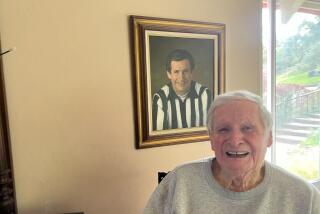Steve Sabol helped turn NFL Films into a Super Bowl champion
- Share via
With Steve Sabol as lensman, editor and resident poet, NFL Films didn’t just capture pro football’s blood-stained quirks and foggy breath, it established an aura you could see and feel.
“The autumn wind is a pirate, blustering in from sea,” he once wrote for voiceover specialist John Facenda, whose bell-tower tones earned him the nickname “The Voice of God.”
So, yeah, in a way, Sabol put words into God’s mouth.
Sabol, an art history major who went on to become one of the most celebrated sports filmmakers of his time, died of brain cancer Tuesday at the age of 69, leaving behind a legacy that can be seen in every video montage from “SportsCenter” to your local news.
Personable and self-deprecating — in his college game program, he facetiously listed his home town as Possum Trap, Miss. — the former Colorado College running back will be remembered, with his father Ed, for developing many of the techniques taken for granted in modern sports broadcasting — super slow-mo, reverse angles, miked players, in highlight segments that always have that unmistakable NFL Films mix of grit and glamour.
Using symphony soundtracks, super close-ups and Sports Illustrated caliber photography, they helped turn pro players into comic book superheroes. But it wasn’t technology alone that elevated NFL Films into a master storytelling colossus, it was a sense of fable, a lyrical style as distinct as the blood caked on Ray Nitschke’s nose.
“We see the game as art as much as sport,” Sabol told the Associated Press before his father was inducted into the Pro Football Hall of Fame last year.
Ed founded the company, and Steve was the creative genius behind its success. Before he was done, Steve would win three dozen Emmys, in all phases of the game — writing, editing, directing, producing — establishing himself as one of sports’ top visionaries.
In a rules-obsessed sport, they broke them all. They would film coaches’ pre-game speeches, the snorts of linemen in the trenches, the give-and-take of teammates during idle moments, then punctuate it with a cheerleader’s hair flip.
Aside from Facenda’s doomsday narrations, super slo-mo was their trademark. It was almost as if they couldn’t slow a spinning football down enough. The slower the rotation of the ball, the more enchanted we were by the moment — as if we were watching something being born.
Which we were: sports television.
“When I played catch as a kid, I always pretended to play in slow motion because I was influenced so much by those films,” remembers Peter Segal, who directed the remake of “The Longest Yard,” using two NFL Films cameramen because they were the only ones who could slow the action the way he wanted.
“Monday Night Football highlights, with [Howard] Cosell narrating NFL Films footage was sometimes the reason I would watch the game,” Segal recalled.
CBS director Tony Verna, who invented instant replay, shared a pioneer’s kinship with the Sabols in their mid-’60s race to find the next cool thing.
“As with instant replay, NFL Films’ use of slow motion, camera angles and the narration of Facenda was not just a technical breakthrough but a conceptual breakthrough,” Verna remembered Tuesday from his Woodland Hills home.
He noted that footage of one of the most famous games in history, the Ice Bowl in 1967, would be lost if it weren’t for the Sabols.
“Only half of their cameras were working, but they went on to record the game,” said Verna, who QB’d the network production of the game. “And it’s a good thing they did since the videotape of the telecast was erased just like the first Super Bowl. ... “
But more than the thousands of miles of film they shot, more than being able to withstand NFL conditions, what Steve Sabol will be remembered best for is applying an art major’s eye to the blood sport of the NFL.
“He combined art and journalism to a degree that I think no other person was able to do,” noted NBC’s Al Michaels on Tuesday. “It’s usually one or the other ... but he was able to blend the two.
“He stripped away some of the mystery of the game,” Michaels said. “And in doing so, he made it more interesting -- rather than less.”
twitter.com/erskinetimes
More to Read
Go beyond the scoreboard
Get the latest on L.A.'s teams in the daily Sports Report newsletter.
You may occasionally receive promotional content from the Los Angeles Times.











